Final report for ONE21-389
Project Information
Interlace Commons is an agroforestry research and education group in the Northeastern United States. It recognizes that agroforestry—specifically silvoarable and silvohorticultural practices, known as alley cropping—faces adoption barriers for farms. The Intergovernmental Panel on Climate Change (IPCC) sees agroforestry as one of the most effective nature-based solutions for climate mitigation and adaptation. In the Northeastern U.S., climate challenges include increased precipitation, prolonged droughts, and herbivory. Agroforestry can help by improving water-use efficiency, preventing soil erosion, enhancing productivity, and boosting biodiversity.
Agroforestry addresses two main issues: 1) enhancing food security and 2) preserving ecosystems in agricultural landscapes. Interlace Commons believes that adopting alley cropping can tackle these challenges, support biodiversity, and diversify rural farm income. When this grant commenced in 2022 there were few working examples of alley cropping practices here in the Northeast. Our hope then and now is that well designed examples will act as living classrooms for farms and service providers to understand not only their usefulness as an intervention that can protect and enhance ecosystem function but as two working models that demonstrate thoughtful design, and best practices for implementation.
Interlace Commons utilized a field consultancy model, a participatory process that included articulating a farm narrative, documenting the biophysical assets and constraints, co-designing the planting plan and participating in the implementation process. This project resulted in two established alley cropping systems, that reached thirty-five service providers and seven hundred and community members. In the case of Umass Amherst one researches is establishing research related to tree establishment utilizing green overcrops that don't compete with the in-row woody species. Two key points from this project: agroforestry service provision needs to be conducted as a participatory process with the farms as committed collaborators in all aspects of the planning process. It's imperative that farms regardless of experience working with trees and shrubs need to be taught the difference between planting trees in single function landscapes and spaces where trees / shrubs can have positive and negative impacts on the arable component.
The project objectives
- Train two farms to develop agroforestry land-use plans focused on alley cropping. This process will help the farms identify alley cropping’s benefits, risks, yields, and best practices for establishment and management, as well as enterprise planning;
- Utilize land-use plans to establish alley cropping demonstration sites for educational and outreach purposes;
- Share the project’s process and results with farmers, technical service providers, conservation planners, and students to reach a range of stakeholders with information about alley cropping and its adoption in the Northeast. This information will be helpful to stakeholders looking to enhance sustainability, address ecosystem degradation, increase profitability, and prepare for/respond to climate change and its impact on the future of farms, food, and the environment;
- Identify funding opportunities to support farms in designing and implementing alley cropping systems.
If successful, this project will catalyze the adoption of alley cropping in the Northeast as a transformative solution to agriculture’s environmental and economic challenges. In the short term, there will be increased interest in and an improved understanding of alley cropping; in the mid- and long-term, there will be an uptick in alley cropping adoption on farms in Massachusetts and surrounding states.
Umass Amherst and Cloud Water Farm received training in alley cropping concepts and best practices via the Interlace Commons planning process that requires farms to write a farm narrative, review biophysical maps, and co-design the planned practice. Storymaps were developed and will be hosted on the Interlace Commons website. Meeting our third objective, was a challenge, planned farmer field days were not well attended in part because of timing. Hosting trainings during the growing season is challenging for farms and service providers to participate. In the case of Cloud Water Farm, Interlace Commons utilized funding from another source to provide training for service providers from Vermont's Natural Resource Conservation Service. Both project partners have close ties to the community and are committed to using their demonstration sites for future learning and research. Interlace Commons is under a cooperative agreement with NRCS in Vermont, acting as the service provider for agroforestry in the State of Vermont. The two participating farms understand where they can access future funds to support further funding for agroforestry.
Extraordinarily productive, annual cropping systems command global agriculture. Single-function monocultures rely on externalities that, with their use, lead to environmental consequences, including GHG emissions. Despite incremental advances, including cover cropping practiced on 1.7% of cropland and 0.8% in organic production, the resulting interventions are not likely to mitigate the degradation issues caused by annual row cropping systems. Agroforestry, specifically alley cropping, which intentionally combines trees with crops, can address the following effects of climate change:
- Increased herbivory-related issues resulting from warming temperatures and shorter winters are occurring and are predicted to increase. Evidence from agroecosystem and forestry practices suggests that herbivore damage is reduced in diverse cropping systems, including tree cropping modalities that provide structural and species diversity;
- Warmer, drier conditions, including sustained periods of drought. The microclimate conditions created by alley cropping can stabilize air/soil temperature making crops more drought-resistant;
- Extreme weather will increase the frequency/severity of wind-related events. Alley cropping can create conditions that lessen wind speed, reducing evapotranspiration by 15-30% and increasing water content in the tillage layer by 5-15%.
Regarding climate mitigation, no-till, reduced, or strip-till on irrigated cropland sequesters 5 tons per carbon/acre whereas alley cropping (that replaces 20% of annual cropland with trees) stores 11 tons per carbon/acre. However, despite the current and predicted climate-related challenges and the science-based evidence supporting alley cropping as a shovel-ready climate mitigation and adaptation tool, this practice’s broad adoption is limited in the Northeast. The need for agroforestry education and technical service provision was evidenced through Meghan Giroux’s graduate research, which identified barriers to adopting agroforestry. Two barriers are relevant to this project: 1) There are a limited number of technical service providers who can train farms to design and install agroforestry practices, with most trained solely in riparian forest buffers and windbreaks; and 2) The USDA’s "total financial obligations” to agroforestry consist of 71% for riparian buffers, 29% for windbreaks and less than 1% for alley cropping, multi-story cropping, and silvopasture.
The lack of adoption of agroforestry in the Northeast matters because there are two imperatives that agroforestry can address: 1) Enhancing food security, and 2) Preserving ecosystems within agricultural lands by growing food in multifunctional landscapes. This project addresses these challenges and the lack of technical service provision to support the adoption of alley cropping. Interlace Commons proposes partnering with The University of Massachusetts/Student Farm and Simple Gifts Farm wherein Meghan Giroux will provide on-farm consultation to support the development and implementation of alley cropping systems on each farm. We aim to demonstrate how different alley cropping typologies can act as a climate adaptation tool, reduce land degradation, improve biodiversity, and produce more than one crop on a single land unit. Such demonstration is essential to alley cropping’s broad adoption as farmers need to see the practice used effectively on-farm to utilize it. Interest in alley cropping is evidenced by the 162 farms in 4 states that applied to Interlace Common’s Field Consultancy Program in 2020.
Cooperators
- - Producer
- - Producer
Research
Objective 1 Methods:
Use Interlace Commons' existing Field Consultancy Program curriculum to guide the land-use planning process that includes:
- Interlace Commons supported our two participating farms in developing a farm narrative that identified challenges, goals, and opportunities, a statement of purpose, and a description of farm enterprises.
- Vermont's ANR website and ARC GIS was used to identify the biophysical conditions of each farm. Biophysical conditions relate to soils, water and water quality, climate, and the farm's geographic location
- An alley cropping field design was (various forms), including a planting aplan influenced by the farm narrative and site assessment documents. Cloud Water Farm Layout
----------------------------------------------------------------------------------------------------------------------------------------------------------------------------------
Objective 2 Methods:
Install the planting plan (s) outlined in the land-use plan using labor supplied by the two farms:
- The planting sites were patterned by laying out the planting lanes in a way that met farm production, goals and adhering to the density required to grow specific crops.
- The farms prepared the planting sites in the fall prior to spring using primary and secondary tillage.
- Trees and/or shrubs on both sites according were implemented in accordance with the planting plan specific to each farm
----------------------------------------------------------------------------------------------------------------------------------------------------------------------------------
Objective 3 Methods:
Phase # 1: A project postcard was developed to announce the dates of the field days being held in 2023. During the summer of 2022, drone images of UMASS Amherst and Simple Gifts Farm were taken. Case studies for each farm are have been developed, highlighting parts of the farm narrative, site assessment, concept, and planting plans. Case studies is now available on the Interlace Commons, website. Year-round educational kiosks is being installed at Cloud Water once the ground is thawed.
We will utilize various methods and provide multiple modes of engagement to maximize the impact of these two demonstration sites.
Phase # 2: Documentation:
- Case studies for each farm have been developed for each farm. Data reveals the species planted; the rationale for their selection (based on the biophysical properties, and goals of each farm); the number of trees/shrubs/plants planted and in what configuration; 4) the process for planting, including the use of any soil amendments and/or mulches and other materials utilized for protection of newly planted website;
- Permanent educational signage has been produced for Cloud Water Farm that explains what agroforestry and alley cropping are including the planting plan. The sign and will be installed this spring when the ground thaws.
Phase # 3: Dissemination:
- Interlace Commons and Cloud Water farm shared the planning process, and field plans at an a design intensive in the fall of 2024. This will help build momentum and interest and clarify the farmers' plans moving forward.
- Meghan and Lisa did not present at either summer or winter conference. The timing of the NOFA winter conference did not work for the producer and the NOFA summer conference was cancelled.
- Interlace Commons hosted one field day with UMass Amherst that was not well attended. Cloud Water farm hosted an intensive as noted above and could not make the time for a second field day. These Field Days were promoted via a postcard sent to farms, agricultural conservation organizations, and technical service providers in Massachusetts, as well as through Interlace Common's and the farms' social media networks and word of mouth.
----------------------------------------------------------------------------------------------------------------------------------------------------------------------------------
Objective 4 Methods: To increase the likelihood of alley cropping's adoption by other farms in the Northeast, we will:
- Both farms were made aware of agroforestry funding opportunities from various programs and organizations.
- Opportunites were identified for alley cropping support via funding opportunities mentioned above.
- A database was created via the Edward Mother Earth Foundation grant.
- The aforementioned data base will be located on the Interlace Commons website in May of 2025.
Umass Amherst, Simple Gifts and Cloud Water Farm engaged in a partnership SARE grant with Interlace Commons to plan for and implement an alley-cropping agroforestry intervention. Both farms were guided through the planning process, which fulfilled the first objective, developing a farm narrative document, site assessment (materials produced by IC and explained to the farm), a concept, and a planting plan. Simple Gifts left the project in August of 2022 to assess the future direction of the farm operation. Interlace Commons pivoted and found another agriculturalist, Cloud Water Farm, located in Waitsfield, Vermont, to replace Simple Gits as a our second program participant in the partnership grant.
The UMass Agricultural Learning Center was created to provide a hands-on, living classroom for students to learn about farming and the horticultural, nursery and landscape industries. Carbon Farming Initiative: demonstrates and trains students in Agroecology and climate change mitigation and adaptation. The institution has several stakeholders involved in the decision-making process. UMass Amherst is the landholder and controlling entity, interacting with the Stockbridge School of Agriculture and the broader agricultural learning community, who are considered secondary decision makers, including: The UMass Student Farm, the Carbon Farming Initiative, an arborist, viticulturist, and entomologist. The Student Farm experiences several biophysical challenges, including soil erosion, a high water table, and subsurface and surface runoff. Social limitations include inconsistent student involvement, lack of project succession, and budgetary constraints. The Student Farm goals include erosion mitigation, the enhancement of species and structural diversity in support of the State apiary. The agroforestry fruit-focused intervention addressed some of the outlined resource concerns while enhancing species and structural diversity in support of the state apiary.
Dave Tepfer and Jeremy Barker Plotkin were the principal operators of Simple Gifts Farm, a community-owned property in North Amherst, near the University of Massachusetts. They cultivated 12 acres of organic vegetables on 50 acres, using an integrated system that included rotational pasture grazing for laying hens, beef cattle, and pigs. The farm marketed its products through a Community-Supported Agriculture (CSA) program and an on-site farm store, which aimed to educate the community about local food production and the associated challenges—biophysical and socio-economic. Soil fertility posed a significant challenge, as did intense precipitation and drought during specific periods, which affected consistent productivity. The farm also faced labor shortages and issues related to production efficiency. Despite these difficulties, they remained committed to improving labor efficiency, striving for net-zero energy use, and diversifying their products while enhancing ecosystem functions. Their alley cropping practice would have helped them diversify income, including during periods when horticultural crops weren't producing. They had hoped to utilize the trees to create cooling microclimates that reduced evapotranspiration.
Cloud Water Farm, operated by Joe Bossen, aims to explore integrating annual and perennial cropping systems on the land. The farm seeks to create a healthy and vibrant ecosystem that supports sustainable livelihoods for those who work it. The systems implemented at Cloud Water Farm are designed to nourish, educate, and foster joy while promoting a livable planet. Currently, the farm produces annual vegetables and small fruits. The farm faces biophysical challenges, located within a floodplain below a 30-acre catchment area.
Additionally, climate change poses challenges, including increased fungal pressures. Cloud Water Farm's goals include serving as an inclusive space for gathering and education, engaging in food production and distribution, sharing plant heritage with indigenous communities, maintaining ecological integrity, and achieving profitability. The installed alley cropping system
Between February and June 2022, farms were guided on developing a farm narrative. Remote and on-site visits were conducted at all three farms. The biophysical assets and constraints were mapped, and the site assessment sheets and maps were reviewed, highlighting any concerns that could influence the design process. Both farms received instruction on design principles related to agroforestry, particularly alley cropping, which covered site preparation, spatial arrangement, planting density, interplanting, and intercropping. This education informed the farm's concept planning exercises. The planning process required modifications to the initial designs, particularly at UMass Amherst, to address the farm manager's concerns regarding space limitations for the alley cropping design. The final planting plan focused on a smaller five-row land unit, showcasing different planting densities for specific crops. Simple Gifts Farm expressed the need to understand enterprise financials and, in some cases, perform economic modeling before finalizing the planting plan. The project's planning process concluded for the aforementioned farms in August 2022. In September 2022, a site visit was conducted at Cloud Water Farm, where the program components and shortened timelines were explained to the farmer. The farm was informed that the plant materials originally ordered for Simple Gifts Farm would instead be installed on their property. The planning process concluded with all three farms developing a farm narrative, creating appropriate site maps, drawing concept plans, and finalizing planting plans.
Plants were ordered in the summer of 2022, and arrangements were made with each farm to store the materials. In late fall 2022, UMass Amherst and Cloud Water Farm prepared their sites for planting with advice and support from Interlace Commons. Stakes, mats, and fertilizer were ordered for delivery to each farm in April 2023. The project ran into plant storage issues on one of the projects. Bare root trees need specific storage conditions, and they were not met, most dried out and died, requiring the project to purchase additional materials. As a result, Interlace Commons held the plant materials for the other project and chose to install small potted plants, which gave us the flexibility with the timing of our planting.
Farms, even those experienced in tree planting, often lack familiarity with proper plant handling procedures. Planting was successfully carried out as scheduled in the spring of 2023. Observations revealed that farms collaborating with Interlace Commons would greatly benefit from educational classes on best practices related to tree planting. Both farms faced difficulties in managing first-year maintenance. There appears to be a disconnect between the farms' understanding of what is necessary to establish and maintain these systems and the practical requirements for success. Adding trees to arable or horticultural landscapes is time consuming and labor intensive. In short, Interlace Commons and other supporting farms need to ensure landowners know the tools and time required for successful outcomes.
Depending on how Cloud Water Farm markets its fruit and berries, additional yearly income from its new planting could create new income starting in year three, between $1,000 and $6,000.00 per year. Similarly, UMass Amherst could generate between $1000 and $3,500 a year after the third growing season. Products from each farm can include fresh produce and value-added products including beverages, syrups, jams, and jellies.
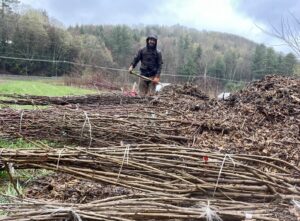
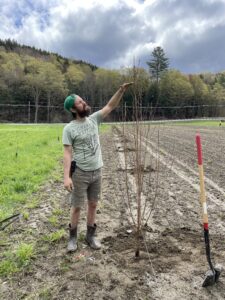
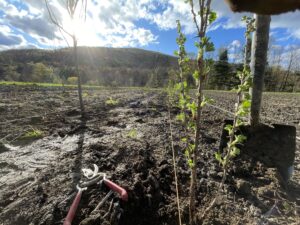

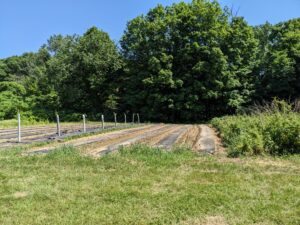
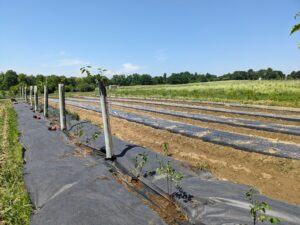
Interlace Commons aimed to create two agroforestry systems tailored for farms focusing on arable or horticultural crops. We planned and implemented two small systems across two farms, covering four acres. Our two sites showcase three typologies and three distinct densities. We planted 260 stems across the two systems, including trees and shrubs. Over time, these small systems should achieve a land equivalency ratio (LER) greater than one, thanks to the farms' increased production efficiency. Specifically, the farms will yield a higher overall production of herbaceous and tree crops when grown together than if cultivated on separate land plots.
We believe we achieved our objective of collaborating through a participatory learning process to help two small farms plan and implement an alley cropping project. We shared knowledge and resources to maintain and enhance their systems over time. We are confident that both producers can teach others the fundamentals of alley cropping. However, we did not effectively disseminate our findings to a wider audience.
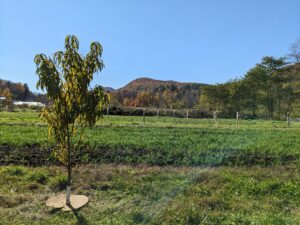
Education & outreach activities and participation summary
Participation summary:
As we initially outlined, we fell short in our ability to disseminate information about our project effectively. That said, Lisa Depiano from UMass is sharing our work with the academic community at the University of Massachusetts Stockbridge School of Agriculture, which includes other faculty and students. Due to time constraints for both participants, we decided to host an intensive for farmers and conservation planners at Cloud Water Farm in the fall of 2024. During this class, Joe shared our process, his experiences as a farm and value added producer, and the challenges and opportunities the project presents.
We attempted to present at the NOFA MA conference, but unfortunately, they canceled their summer event. We held two Field Days in late August and September 2024, one of which was the intensive class mentioned earlier. The Vermont Field Day had a full attendance, leading to a waiting list. In Massachusetts, however, only 10 people enrolled, and only one attended. Case studies live on our website, Lisa's permaculture and Cloud Water Farm's website. We produced a sign that will be installed when the ground melts. The design is attached as a product file.
Although our outreach efforts didn't yield the expected results, we are now making plans with Joe at Cloud Water Farm to conduct a farmer-focused intensive this coming fall. Lisa from UMass is an experienced educator, and the site where the alley cropping project was installed is incorporated into the curriculum of her classes. Lisa did have 787 unique visits to the farm, 80 of which were directly producers. Additionally, her colleagues intend to use this new installation to research various in-row cover crops that can serve as mulch and green manure without competing for water and mineral resources with the trees.

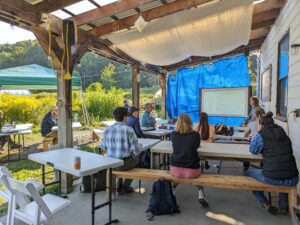
Learning Outcomes
The two farmers acquired the following knowledge and skills:
- Understanding how trees and shrubs can be utilized as a climate adaptation tool
- What the forecasted effects of changing climatic conditions will be, and how those conditions affect the farm at the field and catchment scales
- A fundamental understanding of how to design and implement alley cropping
- Combining land uses is NOT just combining trees with crops; it takes among other things an understanding the cultural requirements of both the trees and crops, density, silviculture, solar radiation.
- Planting the appropriate tree in the correct site conditions
- Learned about what tree and shrub species have existing or emerging markets and where to find enterprise plans to assess the financial feasibility of adding the species to their enterprise(s)
Project Outcomes
Both participating farms transitioned horticultural single-function landscapes into an agroforestry practice called alley cropping. In the case of both farms, the most beneficial outcome is the diversification of their offerings and their future ability to create value-added products from the fruits and berries produced. They may now be able to reach markets that did not exist for them in the past. Secondary outcomes include using their new planting to offer educational events and conduct future research.
Cloud Water Farm
Before partnering with Interlace Commons, CWF was primarily a standard diversified organic vegetable farm that grew annual vegetables in intensive production systems. We had started introducing some perennials, such as asparagus and cider apple trees, into different farm parts. With the lessons learned from this project, we are creating more perennial crop alleys alongside rows of annuals in our other production fields.
**Resulting Benefits or Improvements (Personal):**
I’ve been increasingly concerned about the viability of small farms in our area and across the country. There has been a growing saturation of more traditional crops, and many farms are struggling to adequately compensate farm workers, especially with the rising cost of living affecting labor-intensive crops that still have abundant markets. I feel more optimistic about the future, as we are positioned to be on the early-adopter side of a new wave of crops with significant potential for direct and value-added product markets.
Additionally, climate change presents a significant challenge, with its increasing heavy precipitation, flood risks, disease and pest pressures, drought and extreme heat. By planting alleys of perennials in our crop fields, we support a more diverse population of insects, pollinators, and birds. This also diversifies root structures through soil strata, helping retain soil and moisture, fostering mycorrhizal activity and beneficial soil fauna to support the annual crops that experience tillage. Thanks to these new practices, I see our farm becoming healthier and more resilient across all meaningful metrics.
**Resulting Benefits or Improvements (For Farm Enterprise):**
We believe these practices help protect our crops and soil against the increasing frequency of intense precipitation and drought conditions. Additionally, crop diversity is economically significant, allowing us to complement rather than compete with other farms in our area. Specifically, we host a multi-farm CSA, and by shifting away from the standard market garden crops like tomatoes, peppers, and salad greens to perennials such as asparagus, berries, and stone fruits, we can increase our revenue while enabling our partner farms to do the same. This makes our CSA more unique, interesting, and valuable for patrons, which we hope will help increase membership over time while retaining existing members. It's also important that each farm focuses on a narrower set of crop varieties, allowing us to refine our equipment, post-harvest handling, storage, and marketing efforts, rather than everyone trying to grow and market the same 50 different crops.
**Success Stories and Quotes:**
Many locals who have observed our farm over the last decade or two, even those who don’t join our CSA, speak enthusiastically and curiously about the new patterns they see in the landscape. I enjoy helping our community reimagine what a farm field can look like, and I appreciate the excitement people express when anticipating future harvests of Asian pears, cherries, and peaches, compared to their more subdued enthusiasm for crops like cauliflower.
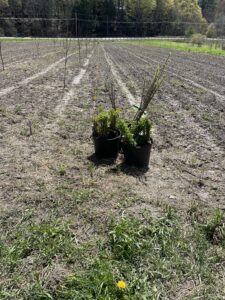
UMass Amherst
Setting up an Alley Cropping demonstration site at the Public Land Grant Flagship Campus of the University of Massachusetts, one of the oldest agricultural colleges in the country, has enabled this climate-smart agricultural technique to reach many aspiring farmers, young people, and other stakeholder groups who might not otherwise have the opportunity to engage with it. The demonstration site is conveniently located at the main entrance of the 40-Acre Agricultural Learning Center (ALC), which serves as a hands-on living classroom and is also home to the UMass Student Farm. In 2024, the site was visited by over 897 "official" visitors, including a diverse mix of the UMass community: students, prospective students, faculty, community members, graduate and PhD students, administrators, extension agents, and members of the Student Farm who regularly come for weekly share pickups and U-Pick fields.
In addition to UMass, visitors also included members of the larger community, such as 4-H participants, the Massachusetts Beekeepers Association, and attendees of the Health Care and Culinary Conference. Beyond the official list, the site is public and frequented by unofficial visitors daily. The demonstration site has also become an outdoor living laboratory for the Stockbridge School of Agriculture, helping train the next generation of farmers to establish, maintain, and experiment with understory plantings and various cropping systems in the alleys. In 2024, the demonstration was utilized in the STOCKSCH 358 Introduction to Agroecology course, where students prepped the winter site, including broadcasting a custom blend of Trifolium. In the STOCKSCH 210 Retail Floral Design course, students planted several varieties of Narcissus in the understory of one row of Pyrus pyrifolia. This experiential education is crucial for training a new generation of farmers by equipping them with traditional agricultural tools alongside innovative, evidence-based scientific methods to tackle an array of interconnected challenges. These experiences allow students to hit the ground running in a growing industry. Moreover, the Stockbridge School of Agriculture's courses are complemented by the new Food, Water, Climate track within the Integrated Concentration in STEM (iCons) program. The UMass iCons Program offers a unique 20-credit undergraduate certificate to inspire a diverse generation of innovators equipped with the attitudes and skills necessary to address societal challenges. Students in this program will utilize the site to gather data for the upcoming iCons 3 laboratory. The iCons Program provides an integrative education for undergraduate science, engineering, public health, policy, and business undergraduate students. It encourages them to: -
- Collaborate in diverse teams on complex societal issues
- Understand multi-faceted problems from multidisciplinary perspectives
- Develop creative solutions to real-world challenges.
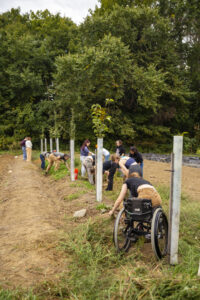
Our approach is sound, but our process of working with farms needs some adjustments. Farms need to understand the challenges of implementation and maintenance. Providing working examples helps farms envision how they can integrate tree cropping practices with their operations. Before this project, few practical examples existed showcasing well-developed silvoarable or silvohorticultural practices. As part of our planning process, I think it would be helpful for farms to engage together with IC and existing projects whenever possible. Understanding how tree density affects shade, potential interactions between tree crops, and the broader economic implications of combining agricultural practices can be challenging. It is essential to assist farms in evaluating enterprise plans and understanding economic models that predict whether they will achieve a land equivalency ratio greater than one. These exercises can help farms make informed decisions about which perennial crops to grow, considering factors such as the planting size and existing and emerging markets. When farms want to engage in this work, it exists now after the final planting plan is completed. The process should happen between concept planning and producing a final plant schedule and design.
Weather predictions are challenging, and educating farmers on how and when to prepare their fields for planting is crucial as the climate becomes more unpredictable. This includes where and how to order various types and grades of materials and proper storage and preparation methods for planting. In one of our two projects, there was a lack of understanding regarding the specific storage requirements for bare-root trees, which resulted in plant mortality. Farms operate on very tight schedules and small profit margins, and as the saying goes, time is money. Farms must be compensated fairly for the actual time spent working on projects. Interlace Commons underestimated the time required for our partner farms to engage with this project. Given the time spent, Interlace Commons does not believe we adequately compensated the farms for their efforts. Fortunately, we supported one of the two partner sites through another non-governmental grant, allowing us to pay them to cater the event and answer questions as part of a program designed to train the federal government. Interlace Commons remains a free resource to our partner farms.
Despite the challenges, we believe this project succeeded in part because of the collaborators we chose. Both are seasoned agricultural producers interested in combining land uses, and could take some risk if the practice fails. In some cases, both are interested and have already utilized their new plantings for educational purposes.
Interlace aimed to implement two distinct alley cropping practices that farms could utilize. This approach sought to understand how participatory design processes could assist collaborating farms in designing and implementing alley cropping effectively. Our hope is that these two capable farms and their associated institutions now have the tools to share resources and best practices while exploring a similar approach that combines conceptual and experiential learning.
Due to climate change, the northeastern United States is expected to face fewer but more intense precipitation events, longer periods of drought-like conditions, and increased herbivory issues. We believe alley cropping is crucial in helping farms adapt to these changes for several reasons. The microclimates created within the alleys formed by trees can benefit horticultural and arable crops while incurring little to no additional cost. Furthermore, structural and species diversity can sometimes reduce herbivory issues, while crop diversification can help protect farmers against total crop failure.
Unfortunately, the United States is desperately behind in temperate agroforestry research compared to its global counterparts. We need more information on how trees and crops interact positively and negatively with each other. Research in alley cropping currently needs to focus on:
- Tree species selection for different climate and soil types
- Tree-crop relationships
- Pest management strategies.
- Economic viability of alley cropping, including crop yields and tree production
- Better models for assessing Land Equivalency Ratio
There is a growing trend among those adopting modern agroforestry practices. In the northeast, small diversified farms are leading this movement. These beneficial practices apply to various land use types, including forest, pasture, arable, and horticultural land, and they are relevant across different scales. The two most requested practices are alley cropping and silvopasture. The sector should continue to focus on early adopters while also making outreach efforts to conventional broadacre growers, particularly in the livestock sector, where ecosystem protection and improvement can have a significant impact. Additional outreach should also target the conservation and forestry sectors that currently emphasize single-function outcomes.